Contents
If consistently warm weather has settled outside the window, and tomato seedlings have already grown enough, then it’s time to think about planting plants in the ground. At the same time, you need to know at what distance to plant tomatoes in order to economically use land and at the same time get the maximum yield of vegetables. Distances between tomatoes depend on the height of plants and growing conditions. You can also use some tricks that will allow you to create compact tomato plantings in the greenhouse and in the open field.
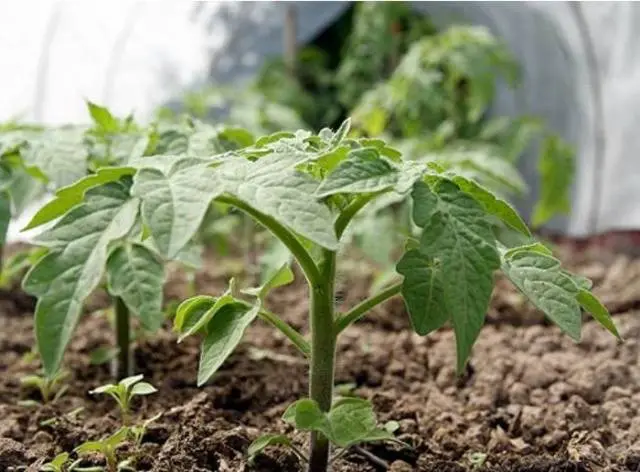
Why is it important to keep the recommended distances?
You can get a good harvest of tomatoes only if you correctly place the seedlings when planting. In pursuit of saving space, many gardeners plant plants too densely, which can lead to undesirable consequences:
- nearby plants shade each other, which does not allow them to develop normally and form fruits in the required quantity.
- in the shade of tomato foliage, the fruits ripen longer, which is not desirable when growing crops in open ground;
- strongly developed roots inhibit the growth of neighboring plants, absorbing a large amount of nutrients;
- care for dense plantings becomes more difficult;
- in protected conditions, there is no natural air circulation, and densely spaced tomato leaves may suffer from fungal diseases;
- close contact of densely spaced tomato leaves contributes to the accelerated spread of diseases from one bush to another.
Thus, the dense placement of tomatoes in the ground can lead to the development of diseases, a lack of nutrients and moisture, a slowdown in the process of fruit ripening, and other consequences that adversely affect the yield of tomatoes.
Planting tomato seedlings at too great a distance from each other is also not a solution to the problem, since in this case it is necessary to give large areas of land for planting. That is why a competent gardener should know what distances are optimal for plants and what schemes for planting tomato seedlings can be used outdoors and in a greenhouse.
Distances depending on the variety
All tomatoes, depending on the shape, tallness, spreading of the bush and the prevalence of its root system, are divided into three types:
- Standard tomatoes sometimes called undersized. The height of their bushes does not exceed 45 cm. The root system of plants is compact, which allows planting tomatoes 6-7 bushes per 1 m2 soil. The trunks of standard tomatoes are thick and strong. Such plants do not need a garter.
- Determinant tomatoes are called medium. Their height does not exceed 1,5 m. The root system is well developed. In the process of vegetation, plants independently limit their growth, while requiring the formation of a bush. Determinate tomatoes are grown in open and protected ground, planting 3-4 plants per 1 m2 soil.
- Indeterminate varieties tomatoes grow throughout their life cycle. Their height can reach 3 m. The developed root system does not allow planting such bushes densely. So, the recommended planting scheme implies the placement of no more than 2 bushes per 1 m2 soil. During the growing season, indeterminate tomatoes must be tied up, stepsoned, pinched.
Thus, when purchasing tomato seeds, it is necessary to pay attention to their classification in order to determine at what distance they will subsequently need to be planted and what rules for caring for plants to follow.
Schemes for planting tomatoes in open ground
Tomatoes should be planted in open ground in early June. At this time, there is no threat of frost, and night temperatures do not fall below +10-+120C. In a greenhouse environment, such conditions occur 2-3 weeks earlier.
Before planting seedlings, you should decide on the plot of land on which the tomatoes will grow. It should be a well-lit, windless area with a predominance of nutrient soil. It is also worth paying attention to what cultures grew early in this place. The best predecessors for tomatoes are cucumbers, zucchini, peas, onions, cabbage, garlic, root vegetables. Do not plant tomatoes in areas of soil where eggplants, peppers or potatoes used to grow.
To grow tomatoes, you must first prepare the soil. During autumn digging, manure, humus or other organic matter should be introduced into the soil. In the spring, with the advent of heat, the soil must be loosened and fertilizers containing phosphorus and potassium added to it. After such preparation, it is necessary to determine which planting scheme and technology is best to use.
Landing in rows
This technology is most common among gardeners. It is used by both experienced and novice farmers. It involves planting tomatoes in the ground in rows according to pre-made markings. It is possible to plant standard and determinate tomatoes using this technology. Depending on the tallness of the tomatoes, there should be distances from 25 to 40 cm between plants in one row. Between the rows of tomatoes, passages 50-80 cm wide should be provided.
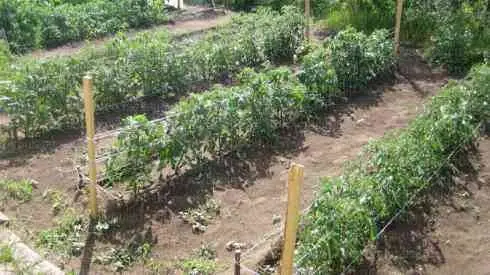
It is worth noting that planting tomatoes in rows is used only on open ground, since the technology requires large areas. At the same time, the advantage of the method is facilitated plant care, good lighting of the bushes, and excellent air circulation. All these factors allow tomatoes to grow freely and produce a full crop in a timely manner.
Parallel landing
This landing technology is similar to the above technique. The only difference is that between the technical passages you need to plant not one, but two rows of tomatoes. This allows you to save land, and at the same time maintain the convenience of servicing plantings. Plants of any height are planted using this technology, while observing the recommended distances: between two rows of distances of 25-50 cm, depending on the height of the bushes, the distance between the bushes in one row is 60-70 cm.
Between two ridges with parallel plantings of tomatoes, a passage should be provided, the width of which should be equal to 80-100 cm. You can see the diagram of such a planting of tomatoes below.
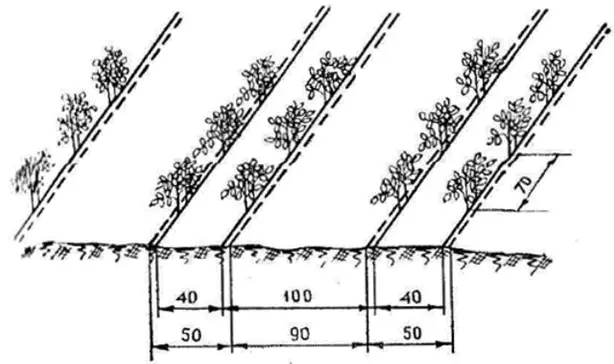
Parallel landing is sometimes called tape-nesting. Use it for growing tomatoes in a greenhouse and on open land.

Landing in a checkerboard pattern
Planting in a checkerboard pattern is more often used for growing determinant tomatoes in open ground. The method allows you to provide plants with maximum sun exposure. At the same time, caring for plants is not difficult, since access to each bush is free.
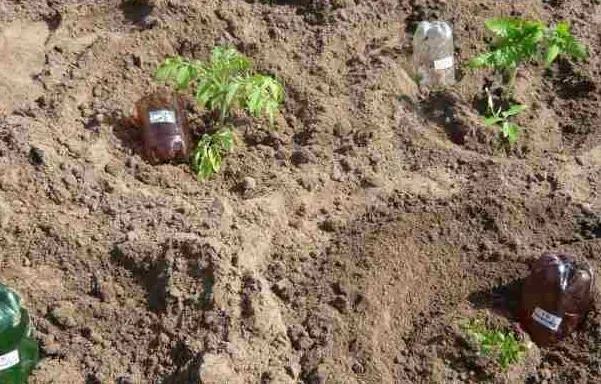
To plant tomatoes in a checkerboard pattern, it is necessary to outline two lines, the distance between which will be 40-50 cm. Tomatoes should be planted on one line, observing the distances between the bushes of 50-60 cm. After filling one line, you can start planting plants on the second line. This will evenly fill the soil and make the landing aligned.
Square nest landing
This technology of growing tomatoes is more often used in industrial enterprises. It involves planting not one, but three tomato seedlings at once in one hole (nest). Nests can be placed on unlimited squares. They are created by marking several parallel lines, at a distance of 80 cm from each other. Nests are made on each line at a distance of 60 cm.
After the tomato seedlings, planted in a square-nest way, adapt to new conditions, one less viable seedling is removed. The remaining two stronger ones are tied up.
Caring for plants with such a planting scheme is quite complicated, however, in practice, the high efficiency of the technology has been proven.
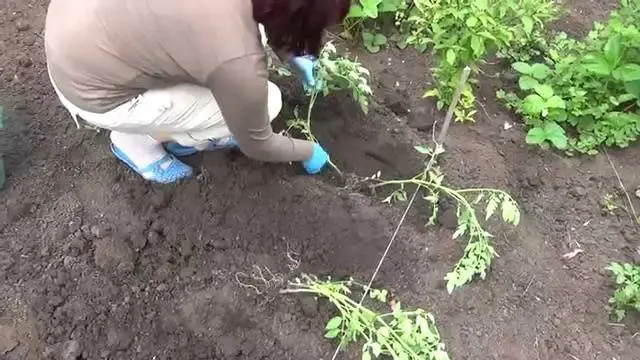
Tomatoes are planted at a distance that depends on their tallness. So, it is better to grow indeterminate tomatoes in rows, because in this case massive bushes will receive enough sunlight, the roots will not be deficient in nutrients and moisture. This arrangement will allow you to grow the maximum crop of vegetables without any special difficulties, because the plants will be located without restricting access to them.
Medium-sized, determinate tomatoes are best planted in a checkerboard pattern to save free soil. Low-growing, standard tomatoes will take up little space, but they will give a good harvest when planted in parallel rows. At the same time, despite all the recommendations, the choice of a scheme for planting tomatoes in open ground depends primarily on the preferences of the gardener and the availability of free soil.
Planting tomatoes in a greenhouse
Most gardeners traditionally grow tomatoes in a greenhouse and greenhouse. This allows plants to be planted in early spring, thereby speeding up the harvesting process. In protected ground, you can plant undersized and tall tomatoes. At the same time, farmers recommend giving preference to indeterminate tomatoes that grow and bear fruit until late autumn. Greenhouse conditions in this case allow you to maintain a favorable microclimate for plants as long as possible.
Soil preparation
It is necessary to prepare the soil for growing tomatoes in a greenhouse in the spring. To do this, you need to sift and disinfect or partially replace the top layer of soil, since it contains pest larvae, seeds and roots of weeds. You can disinfect the soil by heating or spilling a manganese solution. Also, during the preparation of the soil, it is necessary to add rotted manure and a complex of mineral fertilizers with a high content of potassium and phosphorus to it. After fertilization, the soil in the greenhouse should be leveled.
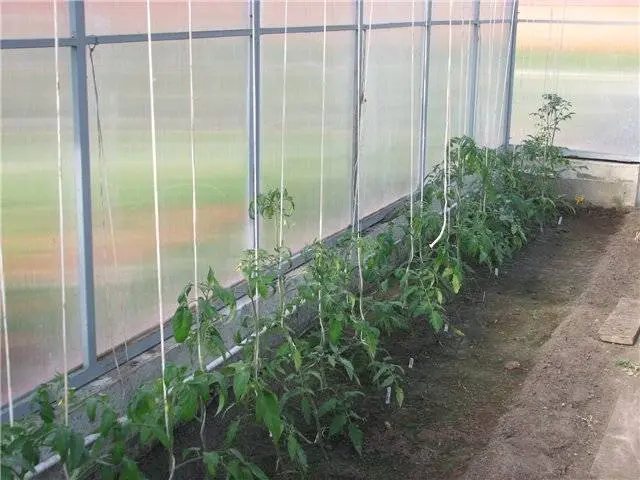
Classic landing methods
After preparing the soil for growing tomatoes in a greenhouse, you need to determine at what distance seedlings need to be planted, given the tallness of the variety. In this case, you can use one of the above disembarkation schemes. However, it is worth remembering:
- planting in rows is not advisable for growing tomatoes in a greenhouse, since it requires the use of large areas;
- square-nest planting of tomatoes is also not recommended for protected conditions, since it requires large areas and makes it difficult to care for plants in a limited space.
At the same time, gardeners most often use the classical scheme of parallel placement of seedlings when growing tomatoes in greenhouses. This scheme with the designation of recommended distances for medium-sized determinant tomatoes is shown below.

The method of planting tomatoes in a checkerboard pattern is also popular with farmers who grow tomatoes in greenhouses and greenhouses. An example of the location of the holes according to this principle can be seen below in the photo.
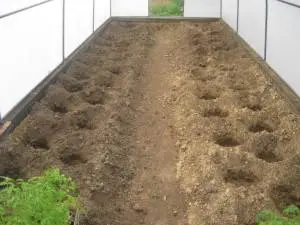
Combined landing
Often gardeners resort to a little trick – a combined planting. It lies in the fact that tall, indeterminate and short, standard tomatoes grow on the same area at the same time. In this case, tall plants must be placed in the middle of the ridge, and undersized tomatoes along its edges. Using this method of growing tomatoes in a greenhouse, special attention should be paid to the formation of bushes.
Shrub formation
For normal growth, development and abundant fruiting, it is necessary to plant seedlings of tomatoes in compliance with certain distances. When purchasing seeds of a particular variety on the package, you can see the recommended distances, however, it should be borne in mind that the manufacturer indicates them, taking into account the correct formation of the bush.
Indeterminate tomatoes are formed in such a way that one main fruiting stem remains. This can be achieved by removing stepchildren. Closer to autumn, indeterminate bushes can be pinched off so that the plants give their strength to the ripening of already existing fruits. Indeterminate bushes must be tied up.
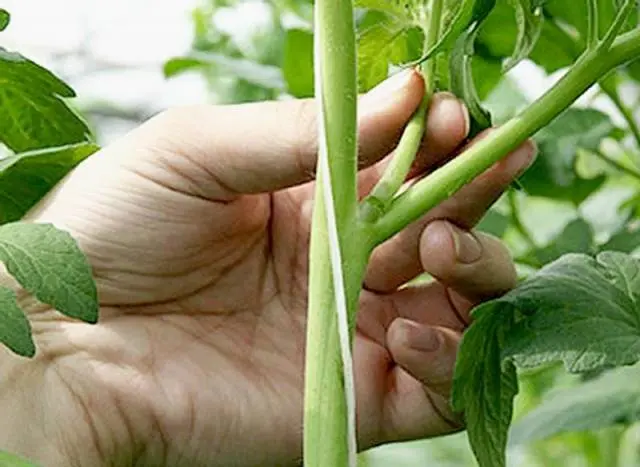
Determinate, medium-sized tomatoes also need to be shaped during growth. The technology for forming bushes in this case involves pinching the main stem upon reaching a certain height and removing stepchildren. At the same time, only some stepchildren are removed, leaving 3-4 fruit-bearing branches below.
Standard and undersized tomatoes do not need to pinch. They, as a rule, independently regulate the intensity of their growth. However, in undersized tomatoes, it is still sometimes necessary to remove lush leaves and stepchildren.
There are no leaves on the flower shoots, while the stepchildren already form leaves in the early period.

Planted tomatoes can be exposed to various fungal diseases. Often their source is contaminated soil. For the prevention of diseases at all stages of cultivation, the lower leaves that touch the soil should be removed.
Details on the formation of tomato bushes can be found in the video:
To summarize
Every gardener should know at what distance to plant tomatoes. This is especially important when growing tomatoes in a greenhouse where there is no natural air circulation, as this can be an impetus for the development of fungal diseases. Compliance with the distances when planting seedlings and the correct formation of tomato bushes allows you to avoid such troubles and at the same time increase crop yields. When growing tomatoes outdoors, following the recommended distances allows the plants to receive more sunlight, resulting in tomatoes ripening faster. Thus, the distance between seedlings, chosen at the time of planting, is the basis for obtaining a good harvest.









